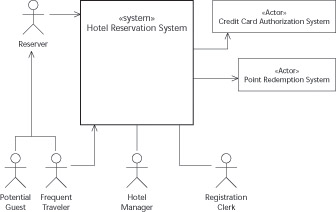Using Context Diagrams
Use-case diagrams are very powerful, but in most systems, the number of use cases you have will be larger than you can conveniently show on one diagram. A popular form of the use-case diagram may help summarize the interaction of actors with the system. This diagram is called a top-level use-case diagram, but as it’s very similar to a type of diagram that predates UML; often you’ll see it called by its traditional name: context diagram. This type of diagram, shown in Figure 8-7, displays the system of interest and all its actors—but it hides the use cases themselves.

Figure 8-7: System context diagram.
When you draw these context diagrams, you don’t have to worry about the arrows. If an actor is always the initiator in all its use cases, you can have the arrow pointing to the system. If an actor is never the initiator, you can have the system pointing to the actor.
You can draw these context diagrams right after you identify the actors—and before you take a crack at the use cases—so a good guess is probably sufficient. To be safe, don’t use the arrowheads if you’re not sure.
As with the regular use-case diagrams, context diagrams can be subdivided into levels. To minimize confusion, focus your diagram on the subsystem, component, or class of interest—and use stereotypes to indicate what the diagram elements are doing.
EAN: 2147483647
Pages: 193